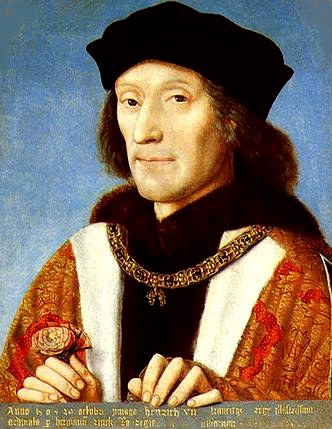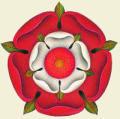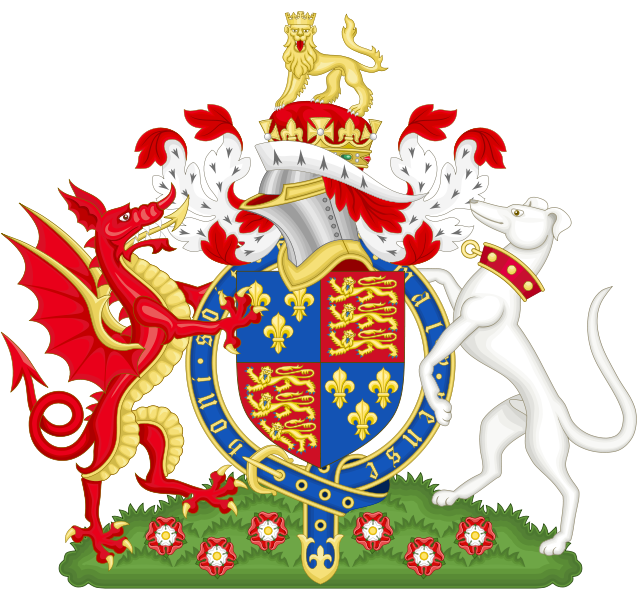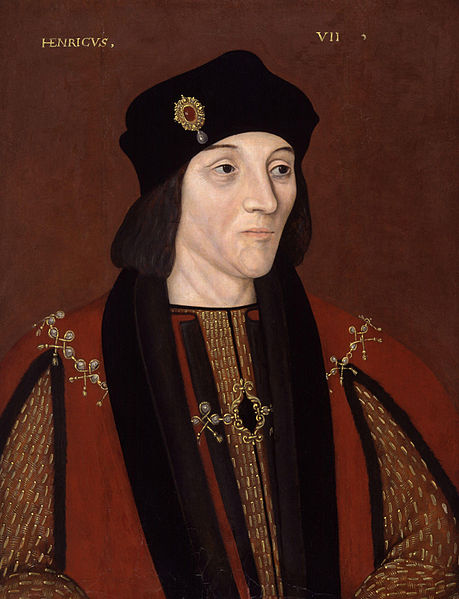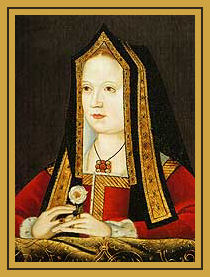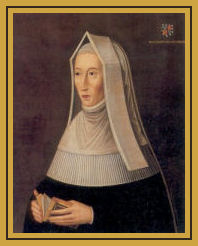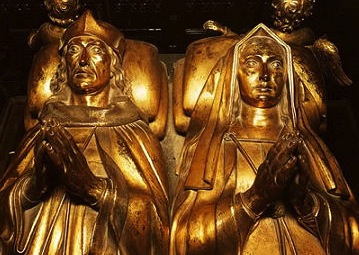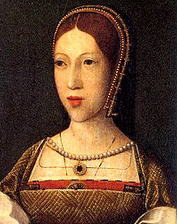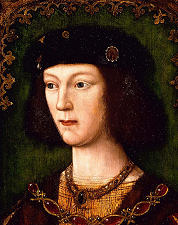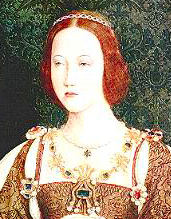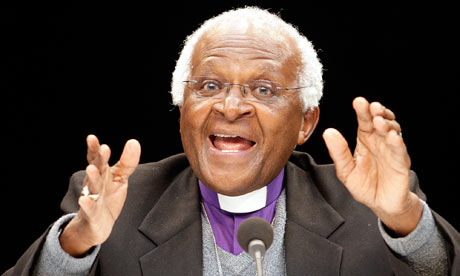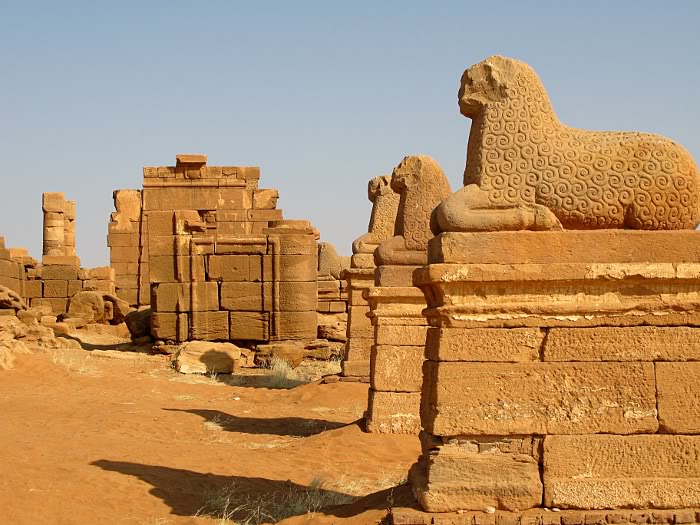Name: King Henry VII
Born: January 28, 1457 at Pembroke Castle
Parents: Edmund Tudor, Earl of Richmond, and Margaret Beaufort
Relation to Elizabeth II: 13th great-grandfather
House of: Tudor
Ascended to the throne: August 22, 1485 aged 28 years
Crowned: October 30, 1485 at Westminster Abbey
Married: Elizabeth of York, daughter of Edward IV
Children: Three sons and four daughters. Only 4 of whom survived infancy; Arthur, Margaret, Henry and Mary
Died: April 21, 1509 at Richmond Palace, Surrey, aged 52 years, 2 months, and 21 days
Buried at: Westminster
Reigned for: 23 years, 7 months, and 28 days
Succeeded by: his son Henry VIII
Henry was the son of Edmund Tudor, Earl of Richmond, who died before Henry was born, and Margaret Beaufort, a descendant of Edward III through John of Gaunt, Duke of Lancaster. Although the Beaufort line, which was originally illegitimate, had been specifically excluded (1407) from all claim to the throne, the death of the imprisoned Henry VI (1471) made Henry Tudor head of the house of Lancaster. At this point, however, the Yorkist Edward IV had established himself securely on the throne, and Henry, who had been brought up in Wales, fled to Brittany for safety.
The death of Edward IV (1483) and accession of Richard III, left Henry the natural leader of the party opposing Richard, whose rule was very unpopular. Henry made an unsuccessful attempt to land in England during the abortive revolt (1483) of Henry Stafford, Duke of Buckingham. Thereafter he bided his time in France until 1485 when, aided by other English refugees, he landed in Wales. At the battle of Bosworth Field, Leicestershire, he defeated the royal forces of Richard, who was killed. Henry advanced to London, was crowned, and in 1486 fulfilled a promise made earlier to Yorkist dissidents to marry Edward IV’s daughter, Elizabeth of York. He thus united the houses of York and Lancaster, founding the Tudor royal dynasty.
Although Henry’s accession marked the end of the Wars of the Roses, the early years of his reign were disturbed by Yorkist attempts to regain the throne. The first serious attempt, an uprising in favour of the imposter Lambert Simnel, was easily crushed (1487). In 1494, Henry sent Sir Edward Poynings to Ireland to consolidate English rule there. Poynings drove out of Ireland the Yorkist pretender Perkin Warbeck, who then sought support from the Scottish king, James IV. James attempted (1496) to invade England, but the next year, under pressure from Spain, he expelled Warbeck. The latter was defeated shortly thereafter in an attempted invasion of Cornwall. A truce (1497) between England and Scotland was followed by the marriage (1503) of Henry’s sister Margaret Tudor, to James a marriage that led ultimately to the union of the monarchies of England and Scotland.
Henry succeeded in crushing the independence of the nobility by means of a policy of forced loans and fines. His chancellor, Cardinal Morton, was made responsible for the collection of these fines, and they were enforced by the privy councillors Empson and Dudley. Henry married his son Arthur to Catharine of Aragón, daughter of Ferdinand II of Aragón and Isabella of Castile, his daughter Margaret to James IV of Scotland, and his youngest daughter Mary to Louis XII of France. After Arthur died in 1502, an agreement was reached by which Catharine married Arthur’s brother Henry (later Henry VIII).
King Henry VII’s Signature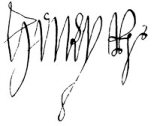 |
| Timeline for King Henry VII |
| 1485 | Henry becomes King after defeating Richard III of York at the Battle of Bosworth Field. The Wars of the Roses are ended. |
| 1486 | Henry marries Elizabeth of York, thereby uniting the houses of York and Lancaster. |
| 1487 | Henry crushes a revolt by the Earl of Lincoln on behalf of Lambert Simnel, a claimant to the throne, at Stoke. |
| 1491 | Henry invades France but at the Treaty of Etaples agrees to withdraw English forces in return for a large sum of money |
| 1492 | Perkin Warbeck an impersonator who claims he is Richard the younger of the Princes in the Tower attempts to overthrow Henry, but is defeated and put to death in 1499. |
| 1492 | Christopher Columbus crosses Atlantic and lands in San Salvador, Cuba and Haiti which he calls the ‘West Indies’ in the belief that he has sailed around the World to India. |
| 1497 | John Cabot sails west from Bristol on the Matthew and discovers New-found-land. He believed it was Asia and claimed it for England. |
| 1499 | Perkin Warbeck is hanged in the Tower of London. The Earl of Warwick is also executed. |
| 1501 | Catherine of Aragon, daughter of King Ferdinand and Queen Isabella of Spain, marries Prince Arthur, Henry’s eldest son. |
| 1502 | Prince Arthur dies, and Prince Henry (the future Henry VIII) becomes heir to the throne, later marrying Arthur’s widow, Catherine of Aragon. |
| 1503 | Margaret, Henry’s daughter marries James IV of Scotland. The marriage gives James’ descendants a claim to the English throne. |
| 1503 | Death of Elizabeth of York, Henry’s wife. |
| 1509 | Henry VII dies at Richmond Palace, at the age of 52. |
Henry VII (Welsh: Harri Tudur; 28 January 1457 – 21 April 1509) was King of England and Lord of Ireland from his seizing the crown on 22 August 1485 until his death on 21 April 1509, as the first monarch of the House of Tudor.
Henry won the throne when he defeated Richard III at the Battle of Bosworth Field. He was the last king of England to win his throne on the field of battle. Henry cemented his claim by marrying Elizabeth of York, daughter of Edward IV and niece of Richard III. Henry was successful in restoring the power and stability of the English monarchy after the political upheavals of the civil wars known as the Wars of the Roses. He founded a long-lasting dynasty and, after a reign of nearly 24 years, was peacefully succeeded by his son, Henry VIII.
Although Henry can be credited with the restoration of political stability in England, and a number of commendable administrative, economic and diplomatic initiatives, the latter part of his reign was characterised by a financial rapacity which stretched the bounds of legality. The capriciousness and lack of due process which indebted many in England were soon ended upon Henry VII’s death after a commission revealed widespread abuses. According to the contemporary historian Polydore Vergil, simple “greed” in large part underscored the means by which royal control was over-asserted in Henry’s final years.
Ancestry and Early Life
The first of the Tudor dynasty, Henry VII won the prize of England’s throne in battle at Bosworth from his Yorkist adversary, Richard III, last of the Plantagenet kings. Henry was considered “the nearest thing to royalty the Lancastrian party possessed” by the country’s Yorkist element, he was the son of Edmund Tudor, Earl of Richmond and Lady Margaret Beaufort and was born on 28th January, 1457 at Pembroke Castle, Wales.
last of the Plantagenet kings. Henry was considered “the nearest thing to royalty the Lancastrian party possessed” by the country’s Yorkist element, he was the son of Edmund Tudor, Earl of Richmond and Lady Margaret Beaufort and was born on 28th January, 1457 at Pembroke Castle, Wales.
Henry’s father, Edmund Tudor, was the half-brother of Henry VI, born of an illicit union between Queen Catherine of Valois, widow of Henry V and Owen Tudor, her Welsh Clerk of the Wardrobe. The discovery of at least three of the queen’s illegitimate children had caused scandal at the time, it was seen as an insult to the memory of the great Henry V. Despite this, Henry VI bestowed the Earldom of Richmond on Edmund and that of Pembroke on his brother Jasper and they in return became staunch supporters of the House of Lancaster.
Henry’s mother, Lady Margaret Beaufort, (pictured below left) from whom he derived his debatable claim to the throne, was an intelligent and learned woman, she was said to be the heir of John of Gaunt after the extinction of Henry V’s line. This was arguable, since her descent was through Gaunt’s illegitimate son John Beaufort, born of the Duke’s affair with his long term mistress Katherine Swynford, whom he later married. It was accepted that the Beauforts were later legitimized by King Richard II, but a clause had been inserted into the document debarring the Beauforts from the throne. This Henry’s adherents conveniently chose to forget.Click for Tudor genealogy.
The future King Henry VII had been born into the civil strife of the Wars of the Roses, Edmund Tudor’s posthumous son, his mother had been only thirteen at the time of his birth. It was reported to have been a difficult confinement. After the death of her husband, Margaret Beaufort had taken refuge in Pembrokeshire, Wales, with her brother-in-law, Jasper Tudor. Henry’s grandfather, Owen Tudor, an ardent Lancastrian supporter, had been executed by the Yorkists after the battle of Mortimers Cross. Many of his Beaufort relations had met their death in the long and bloody drawn out struggle against the House of York.
Prior to Bosworth, Henry had spent much of his life in exile. Although his mother went through three husbands, Henry was Margaret Beaufort’s only child. He had nearly been captured and handed over to Edward IV on one occasion but he had escaped to the court of France, who had backed his expedition to England and his bid for the throne.
Reign
The first concern Henry had was to secure his hold on the throne.
He honoured his pledge of December 1483 to marry Elizabeth of York. They were third cousins, as both were great-great-grandchildren of John of Gaunt. The marriage took place on 18 January 1486 at Westminster. The marriage unified the warring houses and gave his children a strong claim to the throne. The unification of the houses of York and Lancaster by this marriage is symbolised by the heraldic emblem of the Tudor rose, a combination of the white rose of York and the red rose of Lancaster. It also ended future discussion as to whether the descendants of the fourth son of Edward III, Edmund, Duke of York, through marriage to Philippa, heiress of the second son, Lionel, Duke of Clarence, had a superior or inferior claim to those of the third son John of Gaunt, who had held the throne for three generations. In addition, Henry had Parliament repeal Titulus Regius, the statute that declared Edward IV’s marriage invalid and his children illegitimate, thus legitimising his wife. Amateur historians Bertram Fields and Sir Clements Markham have claimed that he may have been involved in the murder of the Princes in the Tower, as the repeal of Titulus Regius gave the Princes a stronger claim to the throne than his own. Alison Weir, however, points out that the Rennes ceremony, two years earlier, was possible only if Henry and his supporters were certain that the Princes were already dead.
Henry’s second action was to declare himself king retroactively from the day before Bosworth Field. This meant that anyone who had fought for Richard against him would be guilty of treason. Thus, Henry could legally confiscate the lands and property of Richard III while restoring his own. However, he spared Richard’s nephew and designated heir, the Earl of Lincoln. He also created Margaret Plantagenet, a Yorkist heiress, Countess of Salisbury sui juris. He took great care not to address the baronage, or summon Parliament, until after his coronation, which took place in Westminster Abbey on 30 October 1485.[25] Almost immediately afterwards, he issued an edict that any gentleman who swore fealty to him would, notwithstanding any previous attainder, be secure in his property and person.
Henry secured his crown principally by dividing and undermining the power of the nobility, especially through the aggressive use of bonds and recognisances to secure loyalty. He also enacted laws against livery and maintenance, the great lords’ practice of having large numbers of “retainers” who wore their lord’s badge or uniform and formed a potential private army.
Henry was threatened by several rebellions in the next few years. The first was the Stafford and Lovell Rebellion of 1486, which collapsed without fighting.
In 1487, Yorkists led by Lincoln rebelled in support of Lambert Simnel, a boy who was claimed to be the Earl of Warwick, son of Edward IV’s brother Clarence (who had last been seen as a prisoner in the Tower). The rebellion was defeated and Lincoln killed at the Battle of Stoke. Henry made the boy, Simnel, a servant in the royal kitchen.
In 1490, a young Fleming, Perkin Warbeck, appeared and claimed to be Richard, the younger of the “Princes in the Tower”.
Warbeck won the support of Edward IV’s sister Margaret of Burgundy. He led attempted invasions of Ireland in 1491 and England in 1495, and persuaded James IV of Scotland to invade England in 1496. In 1497 Warbeck landed in Cornwall with a few thousand troops, but was soon captured and executed.
In 1499, Henry had the Earl of Warwick executed. However, he spared Warwick’s elder sister Margaret. She survived until 1541, when she was executed by Henry VIII.
Henry married Elizabeth of York with the hope of uniting the Yorkist and Lancastrian sides of the Plantagenet dynastic disputes. In this, he was largely successful. However, such a level of paranoia persisted that anyone (John de la Pole, Earl of Richmond, is an example) with blood ties to the Plantagenets was suspected of coveting the throne
After the Battle of Bosworth, Henry announced that he had come to the throne by inheritance, leaving the details studiously vague. Henry secured the person of chief male surviving Yorkist claimant to the throne, the young Edward Plantagenet, Earl of Warwick, who he imprisoned in the Tower. Warwick was the son of George, Duke of Clarence, Edward IV’s brother.
Elizabeth of York, the daughter of Edward IV, whom he had vowed to marry, was escorted to London. He did not marry her until after his coronation, thereby underlining to all that he ruled in his own right but hoped that the marriage would satisfy some of the less extreme Yorkists and lead to their acceptance of the newly established Tudor dynasty.
Elizabeth was tall, fair haired, attractive and gentle natured. The marriage took place on 18th January 1486 at Westminster Abbey. Nine months later, the new Queen was delivered of a son. He was given the symbolic name of Arthur, in honour of the legendary Dark Age British King.
The Tudor rose, the product of art not horticulture, was born, the emblem of a rose both red and white was adopted as one of the king’s badges, meant to symbolize the union of the Houses of Lancaster and York. The Queen’s household was ruled by Lady Margaret Beaufort. The Queen’s own mother, the meddlesome and grasping Elizabeth Woodville, suspected of involvement in Yorkist plots, was shut up in a nunnery and stripped of all her belongings.
Henry and Elizabeth went on to have a large family, four of whom were to survive to adulthood. The birth of Arthur was followed by that of a daughter, Margaret, destined to be Queen of Scots, in 1489, then came Henry, a second son, (the future Henry VIII) on whom his father bestowed the title Duke of York, which had been previously held by the Queen’s brother Richard, one of the ‘Princes in the Tower’. Another daughter followed named Elizabeth for her mother, who did not survive the trials of infancy in Tudor times. A further daughter, Mary was born in 1498, she was briefly to become Queen of France. Then came Edmund and Katherine who both died in infancy.
In the spring of 1486 the new king went on progress through his realm, among other places, he visited York, where Richard III had, through his connections with the city, been very popular. Outwardly at least, he seems to have been well received.
Rebellion broke out in support of a pretender, Lambert Simnel, who posed as the young Earl of Warwick. He was supported by Richard’s appointed heir, John de la Pole, the Earl of Lincoln and Francis Lovell, along with Richard’s sister Margaret, Duchess of Burgundy. Henry paraded the real Warwick through the streets of London to no avail. The rebels landed from Ireland and the king’s army, under the Earl of Oxford, a superb general, met them at Stoke on 16th June,1487. Lincoln himself was killed. Henry dealt leniently with Simnel who was taken and put to work in the palace kitchens.
Henry’s foreign policy was dictated by the need to secure the dynasty he had founded. In 1488 he aided Francis of Brittany. His motives seem to have been to check the power of France, whom he did not want in control of the Channel, as this conjured up the haunting spectre of France, in alliance with the Scots at her northern border, surrounding England, representing a very real threat to her security. Francis eventually accepted French domination. Henry later aided Francis successor, Anne of Brittany.
The King formed alliances with the Emperor Maximilian of Habsburg and Ferdinand and Isabella, the joint sovereigns of Spain, who were eager to gain French territories. To strengthen his dynasty and obtain international recognition of it, Henry signed the Treaty of Medina del Campo with the Spanish monarchs whereby Henry’s eldest son, Arthur, the heir to the throne, was to marry Katherine of Aragon, their youngest daughter. Maximillian, with his characteristic aptitude for self preservation, deserted his allies once his own ends had been achieved.
Anne of Brittany in the meantime, had been forced to accept a proposal of marriage by Charles VIII of France, thereby Brittany had been annexed to France. An English army landed at Calais in 1492. Henry was bought off by Charles with the offer of reimbursement of the cost of his Breton campaigns and the arrears of pension owed to Edward IV (from the Treaty in Piquiny of 1475).
Perkin Warbeck
A second pretender arose to threaten the security of the new regime, Perkin Warbeck, a handsome young man with a superficial resemblance to Edward IV, who claimed to be Richard, Duke of York, the younger of the Princes in the Tower.
Warbeck was purported to have been rescued before his “brother” Edward V had been murdered in the Tower and smuggled abroad to safety. He gained the immediate support of the old Duchess of Burgundy, determined to be a thorn in the side of her brother’s supplanter on the English throne, it was said that she schooled Warbeck in his role, and made him extremely convincing. Sir William Stanley was reported to have said that if this was indeed Edward IV’s son, he would never fight against him.
When Burgundy refused to surrender Warbeck, Henry severed all trade links with Flanders illustrating that securing the Tudor dynasty was put above the economy and all other considerations.
Report was made to the king regarding Stanley’s comments about the pretender. When it was pointed out to the king that it was Sir William Stanley’s timely intervention that had saved his life at Bosworth, he replied that he had also delayed long enough for him to have lost it. Stanley was executed on 16th February 1495. Thereafter Henry’s slighted step-father stayed away from court. Lady Margaret Beaufort herself took a vow of chastity and ceased to co-habit with her husband.
Perkin Warbeck landed in Ireland in July 1495 and besieged Waterford, when the siege was raised he sailed for Scotland where he was welcomed by James IV. The King of Scots formed an alliance with him, marrying Warbeck to his cousin, Lady Katherine Gordon. Their planned invasion of England was however, abandoned.
The pretender then returned to Ireland while his Scots allies conducted border raids. He landed in England but as Henry’s army approached, Warbeck lost his nerve and fled, claiming sanctuary in Beaulieu Abbey but then had a sudden change of mind, surrendered and threw himself on the King’s mercy. Henry was lenient with him and kept him and his wife close at hand, at court.
Arthur, Prince of Wales
 Henry had been haggling with Ferdinand and Isabella for some time regarding the terms of the arranged marriage between his son Arthur and their daughter Katherine of Aragon. The main bones of contention being the dowry she would receive and the two fathers deep distrust of each other, based on past experience. A final marriage treaty was arrived at in October, 1496, after which a proxy marriage took place.
Henry had been haggling with Ferdinand and Isabella for some time regarding the terms of the arranged marriage between his son Arthur and their daughter Katherine of Aragon. The main bones of contention being the dowry she would receive and the two fathers deep distrust of each other, based on past experience. A final marriage treaty was arrived at in October, 1496, after which a proxy marriage took place.
Ferdinand and Isabella raised their fears about sending their daughter to England before the Tudor dynasty was secured by the removal of rival claimants to the throne. Due to his Yorkist descent, Edward, Earl of Warwick, the son of George Duke of Clarence, posed the largest threat to the Tudor claim to the throne.
A plot was hatched whereby an escape attempt would be engineered involving Warwick and Warbeck, who would then be hastily recaptured. This resulted in Warbeck being hanged at Tyburn and Warwick beheaded. Warwick, believed to have been mentally retarded, (his sister later said ‘he did not know a goose from a capon’), was held prisoner all his short life for being who he was and died because he tried to escape.
Catherine of Aragon was sent to England in 1501 and recieved in her new country with much rejoicing. The royal family waited to receive her in London, Henry, still fearing he had been deceived in some way by the cunning Ferdinand and suspecting that Arthur’s bride could be ugly or even worse, deformed, could contain his anxiety no longer and rode with Arthur to see her at Basingstoke. Catherine was a sweet faced, pretty girl with attractive red-gold hair. A pleasant interlude took place, where Catherine danced some of her native Spanish dances for the King and her future husband, who then departed well satisfied. Henry wrote to her parents that he ‘much admired her beauty as well as her agreeable and dignified manner.’
Arthur and Catherine were married at St. Paul’s Cathedral, the bride was given away by Arthur’s ebullient ten year old brother, Henry, Duke of York. There were feasts, jousts and disguisings to celebrate the event. Even the parsimonious Henry, always inclined to be very frugal with money, spent lavishly on the celebrations. The ‘upstart’ Tudor dynasty gained much in prestige from its new-forged links with the powerful House of Trastamara.
Arthur and Catherine where sent to Ludlow, on the Welsh Marches, traditionally the seat of the Prince of Wales. During the spring, an epidemic of sweating sickness was rife in the area and both Arthur and Catherine contracted it. Catherine recovered, but Arthur, a pale thin youth who had never enjoyed robust health, did not and died at Ludlow Castle.
The Death of Elizabeth of York
Henry and Elizabeth were prostrate with grief at the loss of their eldest son and heir and attempted to comfort each other. The survival of the dynasty they had founded now rested on their one surviving son, Prince Henry.
The grieving parents decided to try for another son to secure the succession in the Tudor line. Elizabeth quickly became pregnant. The pregnancy affected her health and she was unwell throughout it. Nine days after giving birth to a daughter, Catherine, she died in the Tower of London, on 11th February, 1503, dying of a post-pregnancy infection on her 37th birthday. The child lived only a day. Henry VII gave his wife a magnificent funeral, Elizabeth was buried at Westminster Abbey in the ornate Henry VII chapel which her husband was building. The young Sir Thomas More wrote an elegiac poem in her memory.
Margaret Tudor
The King’s elder daughter Margaret Tudor , was married to James IV, King of Scots, to seal an alliance with Scotland. Scotland and England concluded the Treaty of Perpetual Peace, the first peace agreement between the two realms in over 170 years. Even before Margaret’s sixth birthday, Henry had considered a marriage between Margaret and James IV as a means of ending James’ support for the Yorkist pretender Perkin Warbeck, Henry escorted his daughter part of the way north, calling en-route to see his aged mother, Margaret Beaufort, at her home in Collyweston, Northamptonshire. It was through this marriage that the Scottish Stuart dynasty were eventually to inherit England’s throne.
The Later Years
New disputes arose between Henry VII and Ferdinand of Aragon, who still could not bring themselves to trust each other. Since his daughter was now widowed, Ferdinand wished to be reimbursed of the first installment of her dowry. Henry, on the other hand, having got the money, was singularly inclined not to part with it and inflamed the situation further by promptly demanding the rest of it.
Henry suggested that he should marry Catherine himself. This proposal met with an icy response from Isabella, ‘It would be an evil thing,’ she wrote ‘the mere mention of which offends the ears’. Agreement was finally reached that Catherine should marry the young Henry, the new heir to the throne. Even this arrangement did not run smoothly, Henry and Ferdinand continued to haggle endlessly about money.
Catherine was forced to live in near penury with a frugal allowance from her father-in-law. Henry at one point instructed his son to repudiate his betrothed and embarked on a series of alternative negotiations with the Habsburgs. This resulted in his younger daughter Mary being betrothed to the Habsburg heir, the ugly and highly inbred, Charles V.
After the death of Elizabeth of York, Henry became somewhat reclusive and even more avaricious. He entertained the idea of marrying Catherine’s mentally deranged sister, Joanna, who since the death of their elder sister, was heiress to her mother’s kingdom of Castille.
Henry VII died on 21st April, 1509 of tuberculosis at the age of 52 and was buried at Westminster beside Elizabeth of York. Their magnificent effigies, provided by his son, Henry VIII and that of Henry’s mother, Margaret Beaufort, (who followed him to the grave but a few months later) by the Renaissance sculptor Pietro Torrigiano can still be seen in the Henry VII chapel at Westminster Abbey.
The Family of Elizabeth of York and Henry VII
The marriage of Elizabeth of York and Henry Tudor was to produce 7 children, of which only 4 survived the perils of infancy in Tudor times:-
*Arthur, Prince of Wales (September 20, 1486 – April 2, 1502) m. Katherine of Aragon
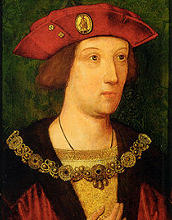
Arthur predeceased his father, Henry VII, he died suddenly at the early age of 15, of the sweating sickness, at Ludlow Castle in the Welsh Marches soon after his marriage to Katherine of Aragon, and is buried at Worcester Cathedral.
There was no issue from the marriage.
*Margaret Tudor, (November 28, 1489 – October 18, 1541) m. (1) James IV, King of Scots (2) Archibald Douglas, Earl of Angus (3) Henry Stewart, Lord Methven.
Issue by (1):-
(i)James Stewart, Duke of Rothesay (1507 – 1508)
(ii)Arthur Stewart, Duke of Rothesay (1509 – 1510)
(iil)JAMES V, King of Scots (1512 -1542) – the father of Mary Queen of Scots
(iv)Alexander Stewart, Duke of Ross (1514 – 1515)
Issue by (2):-
(v)Lady Margaret Douglas (1515 -1578) – the mother of Henry Stuart Lord Darnley, husband of Mary, Queen of Scots
*HENRY VIII (June 28, 1491 – January 28, 1547). m.(1)Katherine of Aragon (2)Anne Boleyn (3)Jane Seymour (4)Anne of Cleves (5)Katherine Howard (6)Catherine Parr
Issue:-By Catherine of Aragon-
Henry Tudor, Duke of Cornwall (b. & died 1511)
MARY I (1516-1558) m. Phillip II of Spain
By Anne Boleyn-
ELIZABETH I (1533 -1603)
By Jane Seymour-
EDWARD VI (1537 -1553)
*Elizabeth Tudor (July 2, 1492 – September 14, 1495).
Elizabeth Tudor died of atrophy, around six months before the birth of her sister Mary. She was buried in Westminster Abbey.
*Mary Tudor (March 18, 1496 – June 25, 1533). m.(1)Louis XII, King of France (2)Charles Brandon, Duke of Suffolk
Issue (by 2):-
Henry Brandon, Earl of Lincoln (1516 -1534) – created Earl of Lincoln by Henry VIII on 18 June 1525 at the age of only two, Henry died at the age of ten or eleven.
Lady Frances Brandon m. (1517 -1559) (1) Henry Grey, Duke of Suffolk (2) Adrian Stokes -the mother of Lady Jane Grey the nine days Queen, who was executed in the reign of Mary I.
Lady Eleanor Brandon (d.1547) m. Henry Clifford, Earl of Cumberland
*Edmund Tudor, Duke of Somerset (February 21, 1499 – June 19, 1500).
Edmund Tudor died at 15 months of unknown causes, and was buried at Westminster Abbey.
*Katherine Tudor (born & died February, 1503).
Katherine Tudor died a few days after her birth.
The Ancestry of Henry VII
| Henry VII | Father: Edmund Tudor, Earl of Richmond |
Paternal Grandfather: Owen Tudor |
Paternal Great-grandfather: Meredith ap Tudor |
| Paternal Great-grandmother: Margaret verch Dafydd |
|||
| Paternal Grandmother: Catherine of Valois |
Paternal Great-grandfather: Charles VI of France |
||
| Paternal Great-grandmother: Isabeau of Bavaria |
|||
| Mother: Margaret Beaufort |
Maternal Grandfather: John Beaufort, Duke of Somerset |
Maternal Great-grandfather: John Beaufort, Earl of Somerset |
|
| Maternal Great-grandmother: Margaret Holland |
|||
| Maternal Grandmother: Margaret Beauchamp of Bletso |
Maternal Great-grandfather: John, Baron Beauchamp of Bletso |
||
| Maternal Great-grandmother: Edith Stourton |
Credits:
Wikipedia
http://www.englishmonarchs.co.uk/
http://www.britroyals.com/

